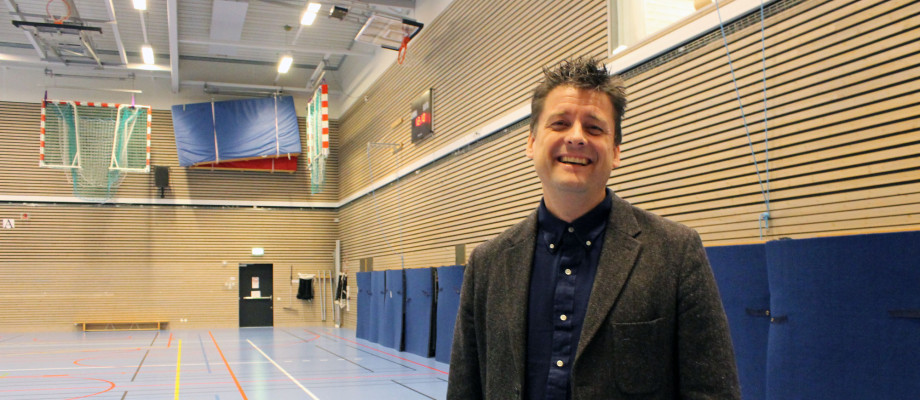NEW PROFESSOR. Since December 1, Mats Börjesson is the new Professor in Sports Physiology at Sahlgrenska Academy and the new Codirector of KHP, the National Center for Health and Performance Development at the University of Gothenburg. Now he has plans to bring in more students and resident physicians to KHP – and especially add more sports medicine to the curricula.
Mats Börjesson studied medicine in Gothenburg and defended his thesis on chest pain in 1999. He worked as a doctor at Östra Hospital for 18 years, until 2011 when he became a professor of community medicine specializing in physical activity at the Swedish School of Sport and Health Sciences (GIH) During the years in Stockholm, he also worked as a cardiologist at Karolinska University Hospital.
The weekly commuting is over now, and since December 1, Mats has been back in Gothenburg with a 70 percent position as a new Professor at Sahlgrenska Academy As professor, he is located at the National Center for Health and Performance Development (KPH) where he is Codirector with Stefan Grau. The rest of the time is spent at Östra, where he is back as a cardiologist and specialist in internal and pain medicine.
From Gais to the national team
It was soccer that made Mats Börjesson focus his research on sports medicine, physical activity and community health. For 20 years, he has been the team doctor for the Gais soccer team as well as the national team doctor for the U21 women’s team, and since 2009, he has been the national team doctor for Pia Sundhage’s national team.

“Interest in sports started with Gais. I also became involved in the Society of Sports Medicine, where I was on the Board for 10 years and of which I have been the Chairman since 2013. It was an interest in soccer that influenced my entering sports medicine.”
During the National Year of Motion 2001, work was initiated to gain proof of the significance of physical activity on health. Healthcare would begin writing out physical activity by prescription (FaR) and Mats Börjesson participated in creating the book, FYSS (Physical Activity in the Prevention and Treatment of Disease).
FYSS describes how physical activity can be used to prevent and treat different diseases.
“The first FYSS was published in 2003 and then again in 2008; now we are preparing the third edition. The new “Fyssen” is even more scientifically rigorous and will be published in 2016,” says Mats Börjesson.
FYSS is distributed worldwide and translated more and more, explains Mats and takes down a FYSS translated into Vietnamese from the bookshelf in the room he has just moved into at KHP.
In addition, BJSM (British Journal of Sports Medicine) will be publishing a themed issue on FYSS soon.
Besides FYSS, Mats is writing a textbook with Professor Mikael Dellborg.
“It will be the first textbook on sports cardiology and I hope that we can release it this spring.”
So far, it is not possible to specialize in sports cardiology in Sweden, but it is possible in other European countries and Mats Börjesson hopes that it is just a matter of time before Sweden follows suit.
Introduced heart screening
After several notable deaths where six Swedish child and youth athletes died within a five-month period, including four boys in connection with soccer training; Mats Börjesson participated in introducing heart screening for elite athletes in Sweden.
“That is when the concept of “Sudden Child Athlete Death” appeared and I had worked with heart screening of athletes at the European level. Since 2005, heart screening is recommended for all elite athletes. Early in 2016, new guidelines on how to interpret an EKG for athletes will be given out.”
At GIH, Mats also participated in the SCAPIS Project – a world’s unique research project within heart, vascular and lung which included comprehensive examinations of the heart and lung status of 30 000 Swedes between the ages of 50-64 years.
“Our group within the project has been responsible for measuring physical activity. We look at motion patterns and condition.”
At GIH, Mats Börjesson was essentially given free rein by the President and he participated in building up a unit for physical activity and health.
“The goal here, at KHP, is to build up a similar expertise on physical activity and health. There is a great deal of knowledge here, but what is most likely needed is the clinical connection and that is what I am here to contribute. We eye some of what we built up at GIH and want to create a hub between the community and the hospital. The collaboration with Daniel Arvidsson, Associate Professor at KHP and expert on motion measurement and nutrition is a start.”
KHP provides a unique opportunity for the sports movement to be able to conduct physiological testing of its elite athletes in Gothenburg. National soccer players are seen in the facilities just as often as those in track and field, figure skating or orienteering.
Many students want to do their degree projects at KHP, where there is plenty of space for research and studies, in addition to gymnasiums, lecture halls, a biomechanics laboratory for motion analysis and strength lab.
“Additionally, I think we have the ability to bring in more resident physicians to do their projects. Essentially, we would like a closer collaboration with Sahlgrenska and that is what we are aiming for.”
The operation at KHP is growing.
“We have excellent facilities and space, which we are now filling with people. Now is when the excitement begins, when researchers arrive who can run projects and attract students.”
“The networks that are being built are important. I hope that we can be a unit that people turn to when they discuss physical activity in their studies and that we can produce many of our own results,” says Mats Börjesson.











